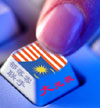An autumn exposition in Shanghai
I'm looking forward to my upcoming trip to Shanghai in September, primarily for the opportunity to visit the World Expo 2010 which will end on 31 October 2010.
The theme for this Expo is "Better City, Better Life" and it makes me wonder, amidst the brouhaha over what Malaysia eventually offered to the world, did Madame Yen Yen missed something crucial in the brief for the theme?
The theme for this section of Shanghai Expo is to dicuss how to build a better city for mankind, which represents the wish of the whole world for better standards of living in future urban environments. There is a deep concern for the improvement of urban environments lying behind this theme. The number of city inhabitants has risen constantly since 1800, and by 2010, as estimated by the United Nations, urban dwellers will account for 55% of the world population. The pursuit of better living environments has accompanied the history of urban development. Shanghai World Expo, through its many sub-themes, depicts a vision of future urban life.
Our Malaysian Pavilion, instead of evoking feelings of pride has dismally became the butt of jokes and indignant anger. Just visit here to get a sense of how some people feel about it:-
I got really angry when i see the malaysian pavillion at the word expo!!! BENCI!! can someone sue this people yg design benda bodoh tu??!!!! We can design better la kan!!! BODO!
Strong words indeed, but real funny when you read the accompanying write-up in that blog posting. You can also check out what Teresa Kok, the Sassy MP has to say about it here.
So I'm itching to see how my government managed to spend RM35million on a structure which has drawn more bile than honey from the taxpayers, not least the fact that they spectacularly "terkeluar tajuk" from the main theme.
That aside, the weather should be nice and cool hovering around 23 degC by the time I'm there. One thing I particularly like about Shanghai is its interesting mix of buildings and structures of various architectural styles, a rich study of contrasting Eastern and Western influences, old and new.
The Bund, located by the bank of the Huangpu River, contains a rich collection of early 20th century architecture, ranging in style from neoclassical HSBC Building to the art deco Sassoon House. A number of areas in the former foreign concessions are also well preserved, most notably the French Concession. Shanghai has one of the worlds largest number of Art Deco buildings as a result of the construction boom during the 1920s and 30s. One of the most famous architects working in Shanghai was László Hudec, a Hungarian architect who lived in the city between 1918-1947. Some of his most notable Art Deco buildings include the Park Hotel and the Grand Theater. Other prominent architects who contributed to the Art Deco style are Parker & Palmer who designed the Peace Hotel, Metropole Hotel and the Broadway Mansions, and Austrian architect GH Gonda who designed the Capital Theatre.
Despite rampant redevelopment, the old city still retains some buildings of a traditional style, such as the Yuyuan Garden, an elaborate traditional garden in the Jiangnan style.
In recent years, a large number of architecturally distinctive, even eccentric, skyscrapers have sprung up throughout Shanghai. Notable examples of contemporary architecture include the Shanghai Museum, Shanghai Grand Theatre in the People's Square precinct and Shanghai Oriental Arts Center.
http://en.wikipedia.org/wiki/Shanghai
Shanghai is always a delightful place to visit. I've been there twice before, both during the cold winter season so this time around, I'm going to experience the city as summer ends and autumn creeps in. It's also a good opportunity for me to eat heartily this time around since I've lost some weight recently. That thought alone is enough to make me smile.







0 Comments:
Post a Comment
<< Home